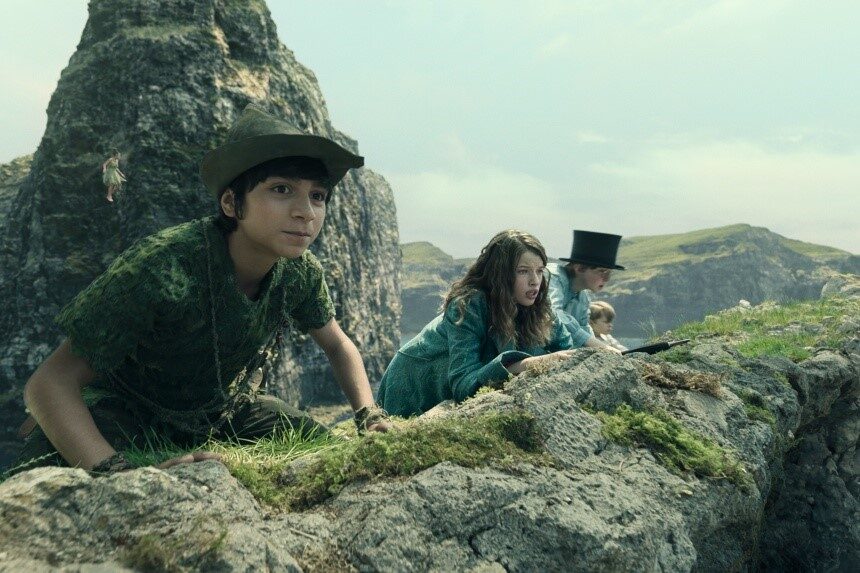Peter Pan & Wendy
⭐️ ⭐️ ⭐️
Rating: PG
Run Time: 1 hour 46 minutes
Stars: Jude Law, Jim Gaffigan, Alexander Molony, Ever Anderson, Yara Shahidi
Writers: David Lowery, Toby Halbrooks
Director: David Lowery
Streaming on Disney+
Fanciful and frightening, Disney’s sumptuous live-action Peter Pan remake hits all the narrative notes of the studio’s 1953 animated classic, bringing enough fresh insights to keep the whole thing from feeling like just another Mouse House retread.
It helps mightily that the movie is co-written and directed by David Lowery, the ingeniously subversive filmmaker responsible for the dark, often disturbing cult classics A Ghost Story and The Green Knight. Lowery also possesses pretty good Disney bonafides, having directed the studio’s 2016 remake of Pete’s Dragon, which was, in every way, superior to the original.
In Lowery’s hands, the story confronts head-on what was only hinted at in the original: The uneasy tension between the Boy Who Refuses to Grow Up and the Girl on the Verge of Womanhood. For the first time I can remember in a Peter Pan film, Peter and Wendy are not a pair of similarly matched adolescents: Here, Peter is played by wide-eyed, diminutive Alexander Molony, while statuesque teen Ever Anderson costars as Wendy. He is very much a little boy (albeit a little boy with Olympic-class sword skills) and she is, as Louis Jordan sang of Leslie Caron’s Gigi, “trembling on the brink.” They are, in every way, from different worlds.
As in most Pan accounts, Peter arrives one night in the nursery occupied by Wendy and her two younger brothers. With a sprinkling of pixie dust, he flies with them to his home, the faraway island of Neverland (“Second star to the right and straight on till morning”). There they are almost immediately fired upon by a pirate ship skippered by the infamous Captain Hook, who takes prisoner Wendy’s two younger brothers.
More than any other character in J.M. Barrie’s original play, Hook is the one who has enjoyed the most lavish attention in the form of iconic performances. Hans Conried voiced him memorably as a fierce iconoclast in 1953, but just a year later, here came Cyril Ritchard, flouncing across the Broadway stage — and, later, TV screens — in Mary Martin’s version (that production cast Ritchard as both Hook and Wendy’s father, which opened all kinds of worm cans). And while Steven Spielberg’s Hook may not rank atop the director’s oeuvre, you can’t blame Dustin Hoffman, who as the not-so-good captain chewed the Neverland scenery with admirable aplomb.
Here, two-time Oscar nominee Jude Law (Cold Mountain) grabs hold of the rusty hook and refuses to let go (well, until the bitter end, that is). This is, by far, the most nuanced Hook we’ve seen for the simple reason that Lowery and co-writer Toby Halbrooks have chosen to explore the unanswered (indeed, previously unasked) question: “Why does Captain Hook hate Peter Pan so much?”
The answer is an ingenious one, and it makes all kinds of nifty narrative sense: It turns out Hook and Peter are actually childhood friends who went their separate ways in the most unusual manner: Hook chose to grow up and Peter refused to, resulting in a bitter split.
But in Lowery’s sophisticated telling, this is more than an unfriendly spat: Here, Peter Pan becomes a meditation on the universal tension between the recklessness of youth and the caution of age; a young person’s wild resentfulness of authority and an elder’s crotchety adherence to norms.
Granted, here those conflicts are worked out with not much conversation and lots of CGI-enhanced swordplay, but Peter Pan & Wendy must, nevertheless, be awarded points for its willingness to offer something beyond “entertainment for the whole family.”
It’s also pretty scary: As in the cartoon version, there are perilous episodes of walking the plank and momentary presumptions of death. But while adults will soon catch on to this version’s winking acknowledgement that no one actually comes to bad end in storybook land, young kids may be especially disturbed by the cruelty and randomness with which Hook metes out punishment.
If Lowery seems especially intrigued with the Peter-versus-Hook theme, it’s because he pursues it at the expense of the titular Peter-and-Wendy relationship. Indeed, there are remarkably few scenes involving just those two, and their apparent age difference doesn’t help cement the notion that the pair have any special kind of connection. Appealing as the two young stars are, at times they seem to be in separate movies.
The fine supporting cast includes comedian Jim Gaffigan as Hook’s sidekick, Mr. Smee, and Yara Shahidi of TV’s Black-ish as Tinkerbell (as a nice feminist touch, Tink’s voice — that of a jingling bell — is decipherable only to Wendy, the one character willing to try and listen to her).
As with many earlier Disney films, 1953’s Peter Pan included some now-problematic racial stereotypes, especially regarding Neverland’s Indian tribe: a clownish group of teepee dwellers. Lowery & Co. have gone to extraordinary lengths to avoid that trap: Not only are the tribe members here played by indigenous people — led by Canadian Cree actress Alyssa Wapanatâhk as Tiger Lily — but their dialogue is peppered with authentic Cree phrases and their English is representative of how a lifelong Cree speaker would approach it.
There is, however, something inorganic about how those characters are used in the film; they come and go, arriving only when they’re needed to move the plot along. As such, their involvement seems more of an apology for the original Peter Pan’s cowboys-and-Indians treatment than a narrative necessity.
With respectful nods to the cartoon classic — the strains of “You Can Fly” echo in the score by frequent Lowery collaborator Daniel Hart — Peter Pan & Wendy manages to feel like its own movie, proving that good film stories, like boys in Neverland, never grow old.
Become a Saturday Evening Post member and enjoy unlimited access. Subscribe now




Comments
Alexander Molony (Peter) was 14 and Ever Anderson was 13 when they filmed this
Great stuff!